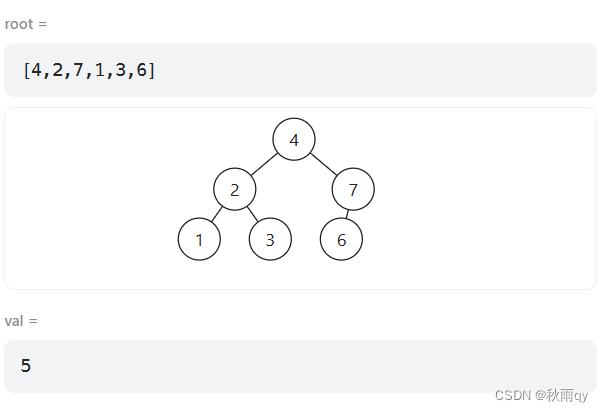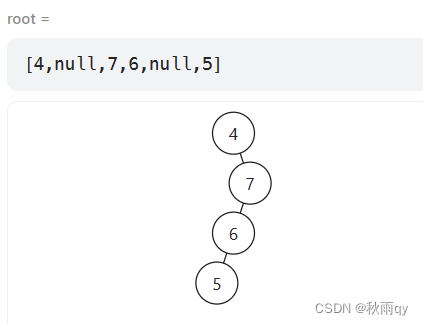数据结构(六)—— 二叉树(6)二叉搜索树
文章目录
- 题
- 1 700 二叉搜索树中搜索指定元素
- 开塞递归
- 递归2(利用二叉搜索树)
- 递归3(bj)
- 迭代
- 2 98 验证二叉搜索树
- 3 530 二叉搜索树的最小绝对差
- 递归中序遍历转化为数组
- 递归
- 4 501 二叉搜索树中的众数
- 额外的内存开销(哈希表)
- 无额外内存开销,重复利用二叉搜索数中众数相邻的特点
- 5 701 二叉搜索树中的插入操作
- 递归
- 迭代
- 6 108 将有序数组转换为二叉搜索树
- 中等题
- 1 450 删除二叉搜索树中的节点
- 2 669 修剪二叉搜索树
题
1 700 二叉搜索树中搜索指定元素
开塞递归
我并没有用到二叉搜索树这个前提
1、输入输出TreeNode* searchBST(TreeNode* root, int val)
2、退出:遍历到空或者满足输入的int则退出
if(root == nullptr || root->val == val) return root;
3、层级逻辑
TreeNode* temp;
temp = searchBST(root->left, val);
if(temp == nullptr){
temp = searchBST(root->right, val);
return temp;
}
return temp;
其中的if的逻辑为:如果没有在左子树上搜索得到能用的TreeNode再搜右子树
4、整合
TreeNode* searchBST(TreeNode* root, int val) {
if(root == nullptr || root->val == val) return root;
TreeNode* temp;
temp = searchBST(root->left, val);
if(temp == nullptr){
temp = searchBST(root->right, val);
return temp;
}
return temp;
}
递归2(利用二叉搜索树)
TreeNode* searchBST(TreeNode* root, int val) {
if (root == NULL || root->val == val) return root;
TreeNode* result = NULL;
if (root->val > val) result = searchBST(root->left, val);
if (root->val < val) result = searchBST(root->right, val);
return result;
}
递归3(bj)
不算遍历了整颗搜索树
class Solution {
public:
TreeNode* temp = NULL;
void bfs(TreeNode* root, int val){
if(root == nullptr ||temp != nullptr) return;
if(root->val == val) temp = root;
bfs(root->left, val);
bfs(root->right, val);
return;
}
TreeNode* searchBST(TreeNode* root, int val) {
bfs(root, val);
return temp;
}
};
迭代
充分利用二叉搜索树特性,左小于中、右大于中
TreeNode* searchBST(TreeNode* root, int val) {
while (root != NULL) {
if (root->val > val) root = root->left;
else if (root->val < val) root = root->right;
else return root;
}
return NULL;
}
2 98 验证二叉搜索树
中序遍历下,输出的二叉搜索树节点的数值是有序序列。所以可以利用递归中序遍历将二叉搜索树转变成一个数组
class Solution {
public:
void trans(TreeNode* root, vector<int>& vec){
if(root == nullptr) return;
trans(root->left, vec);
vec.push_back(root->val);
trans(root->right, vec);
return;
}
bool isValidBST(TreeNode* root) {
vector<int> vec;
trans(root, vec);
for(int i = 0; i < vec.size() - 1; ++i){
if(vec[i+1] <= vec[i]) return false;
}
return true;
}
};
3 530 二叉搜索树的最小绝对差
递归中序遍历转化为数组
与2一样,可以转化为vector,然后相邻元素相减,保存最小的减数
class Solution {
public:
void trans(TreeNode* root, vector<int>& vec){
if(root == nullptr) return;
trans(root->left, vec);
vec.push_back(root->val);
trans(root->right, vec);
return;
}
int getMinimumDifference(TreeNode* root) {
int res = INT_MAX;
vector<int> vec;
trans(root, vec);
for(int i = 0; i < vec.size() - 1; ++i){
res = min(res, vec[i+1] - vec[i]);
}
return res;
}
};
递归
核心技巧:递归中记录前一个节点的指针
trans(root->left, res); // 左
if(pre != nullptr) res = min(res, root->val - pre->val); // 中
pre = root; // 记录前一个
trans(root->right, res); // 右
class Solution {
public:
TreeNode* pre = NULL;
void trans(TreeNode* root, int& res){
if(root == nullptr) return;
trans(root->left, res);
if(pre != nullptr) res = min(res, root->val - pre->val);
pre = root; // 记录前一个
trans(root->right, res);
}
int getMinimumDifference(TreeNode* root) {
int res = INT_MAX;
trans(root, res);
return res;
}
};
4 501 二叉搜索树中的众数
额外的内存开销(哈希表)
class Solution {
public:
void trans(TreeNode* root, unordered_map<int,int>& visit) {
if(root == nullptr) return;
trans(root->left, visit);
visit[root->val]++;
trans(root->right, visit);
}
vector<int> findMode(TreeNode* root) {
vector<int> res;
unordered_map<int,int> visit;
int fre = INT_MIN;
trans(root, visit);
for(auto [a,b] : visit){
fre = max(fre, b);
}
for(auto [a,b] : visit){
if(b == fre) res.push_back(a);
}
return res;
}
};
复习:遍历哈希表的两种方式
for (auto it = visited.begin(); it != visited.end(); ++it){
it->first // key
it->second // val
}
或
for(auto [a,b] : visited){
a // key
b // val
}
哈希映射
for (auto it = visited.begin(); it != visited.end(); ++it)
*it // val
无额外内存开销,重复利用二叉搜索数中众数相邻的特点
二叉搜索数中相同元素一定相邻
1、递归函数为dfs
2、逻辑处理在update函数中
class Solution {
public:
vector<int> answer;
int base, count, maxCount;
void update(int x) {
if (x == base) {
++count;
} else {
count = 1;
base = x;
}
if (count == maxCount) {
answer.push_back(base);
}
if (count > maxCount) {
maxCount = count;
answer = vector<int> {base};
}
}
void dfs(TreeNode* o) {
if (!o) {
return;
}
dfs(o->left);
update(o->val);
dfs(o->right);
}
vector<int> findMode(TreeNode* root) {
dfs(root);
return answer;
}
};
5 701 二叉搜索树中的插入操作
插入题
返回值为树的题,还有617合并二叉树,在二叉树(5)中。
这道题根本不用重构,只需要找到合适的空节点位置插入就好了。
递归
1、输入输出
TreeNode* insertIntoBST(TreeNode* root, int val)
2、退出条件
遍历到了合适的空节点
if (root == NULL) {
TreeNode* node = new TreeNode(val);
return node;
}
3、单层逻辑
这是搜索树,遍历整棵搜索树简直是对搜索树的侮辱
if (root->val > val)
root->left = insertIntoBST(root->left, val);
if (root->val < val)
root->right = insertIntoBST(root->right, val);
return root;
4、整合
TreeNode* insertIntoBST(TreeNode* root, int val) {
if (root == NULL) {
TreeNode* node = new TreeNode(val);
return node;
}
if (root->val > val)
root->left = insertIntoBST(root->left, val);
if (root->val < val)
root->right = insertIntoBST(root->right, val);
return root;
}
补充:需要了解此题与 617合并二叉树 的区别
问题:
为什么不能像617那样新创建一个节点?如下所示:
TreeNode* newNode = new TreeNode(root->val);
if (root->val > val)
newNode->left = insertIntoBST(root->left, val);
if (root->val < val)
newNode->right = insertIntoBST(root->right, val);
return newNode;
这样会有问题,他会返回所添加元素5的最短路径,如下所示:
示例:

错误答案:

本应该是:

迭代
TreeNode* insertIntoBST(TreeNode* root, int val) {
if (root == NULL) {
TreeNode* node = new TreeNode(val);
return node;
}
TreeNode* cur = root;
TreeNode* parent = root; // 这个很重要,需要记录上一个节点,否则无法赋值新节点
while (cur != NULL) {
parent = cur;
if (cur->val > val) cur = cur->left;
else cur = cur->right;
}
TreeNode* node = new TreeNode(val);
if (val < parent->val) parent->left = node;// 此时是用parent节点的进行赋值
else parent->right = node;
return root;
}
6 108 将有序数组转换为二叉搜索树
删除二叉树节点,增加二叉树节点,都是用递归函数的返回值来完成,这样是比较方便的。
首先是传入数组,然后就是左下标left和右下标right,我们在二叉树:构造二叉树登场! (opens new window)中提过,在构造二叉树的时候尽量不要重新定义左右区间数组,而是用下标来操作原数组。
1、输入输出
TreeNode* traversal(vector<int>& nums, int left, int right) {
这里注意,这里定义的是左闭右闭区间,在不断分割的过程中,也会坚持左闭右闭的区间,这又涉及循环不变量。
在106.从中序与后序遍历序列构造二叉树,35.搜索插入位置 和 59.螺旋矩阵II 都详细讲过循环不变量。
2、退出条件
if (left > right) return nullptr;
3、单层逻辑
1 首先取数组中间元素的位置,不难写出int mid = (left + right) / 2;,这么写其实有一个问题,就是数值越界,例如left和right都是最大int,这么操作就越界了,在二分法 中尤其需要注意!所以最好这么写:int mid = left + ((right - left) / 2);
2 取了中间位置,就开始以中间位置的元素构造节点,TreeNode* root = new TreeNode(nums[mid]);
3 接着划分区间,root的左孩子接住下一层左区间的构造节点,右孩子接住下一层右区间构造的节点。
4 最后返回root节点,单层递归整体代码如下:
int mid = left + ((right - left) / 2);
TreeNode* root = new TreeNode(nums[mid]);
root->left = traversal(nums, left, mid - 1);
root->right = traversal(nums, mid + 1, right);
return root;
中等题
1 450 删除二叉搜索树中的节点
删除题
不可避免的要调整树的结构
1、如果删的节点是叶子节点==不需要调整树的结构
2、
